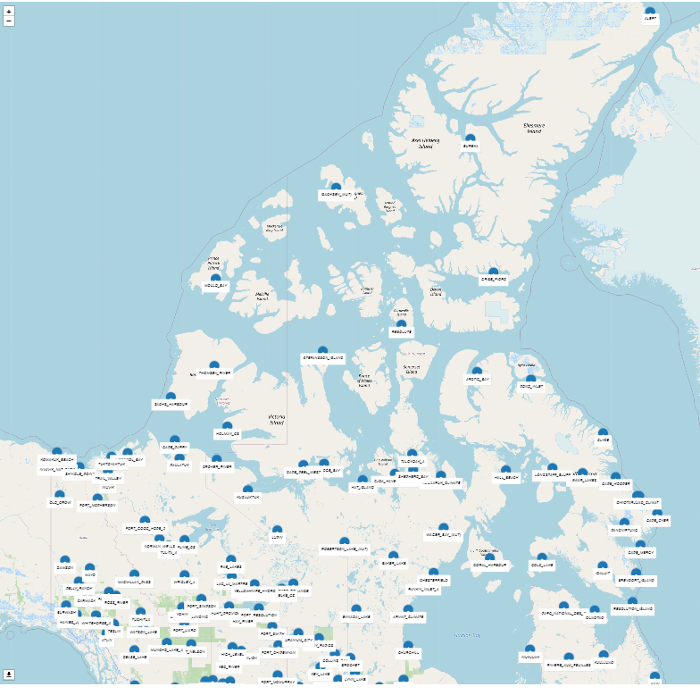Overview
Adjusted and homogenized Canadian climate data (AHCCD) consist of monthly, seasonal and annual means of wind speed at a standard 10m level for more than 150 locations in Canada. The data at stations incorporate adjustments (derived from statistical procedures) to the original historical station data to account for discontinuities from non-climatic factors, such as instrument changes or station relocation. Daily observations from nearby sites were often merged into a single record to create a long-time series
Provider's contact information
Environment and Climate Change Canada
Contact info.cccs-ccsc@canada.ca for information related to monthly, seasonal and annual data.
Licensing
Open Government Licence - Canada.
The end-user licence for Environment and Climate Change Canada's data servers specifies the conditions of use of this data.
Variable name and units:
Wind speed (km/h)
Spatial coverage and resolution:
Canada, point location.
Temporal coverage and resolution:
Time period varies per station with data for most stations in the North starting in 50’s and ending in 2014.
The data is available at monthly, seasonal and annual time steps.
Information about observations (number, homogeneity)
The following table presents the number of stations per region and variable:
| Region | Wind |
|---|---|
| Yukon | 18 |
| NWT | 31 |
| Nunavut | 40 |
| North Quebec | 15 |
| Labrador | 8 |
The figure below shows the position of stations in northern Canada.

Methodology
The daily AHCCD station data are derived from observations made at the weather stations from the Meteorological Service of Canada (MSC) and use the same ID as MSC stations; this allows users to compare the raw station data to homogenized and adjusted data. The AHCCD dataset was developed for use in climate research, including climate change studies that needs long-term data records. Over long periods, meteorological records are subject to changes (e.g., site exposure, location, instrumentation, observer, and observing procedures) that are not related to climate. These non-climatic changes were detected and removed in AHCCD using statistical procedures.
There are two steps used to homogenize surface wind speeds. First, metadata and logarithmic wind profile are used to adjust hourly wind speeds measured at non-standard height to the standard 10m level. Then, the monthly mean wind speed series are derived from the anemometer height adjusted hourly wind speeds and tested for homogeneity by a statistic inhomogeneity model based on regression models (Wang, 2008), using homogeneous monthly mean geotropic wind speed series as reference series (which were derived from homogenized hourly sea level pressure data recorded at Canadian and US stations). Series of annual and seasonal mean temperatures were tested separately for homogeneity using neighbour observations as a reference series.
The methodology involves the identification of inhomogeneities in the wind speed series, which are often non-climatic steps due to station alterations including changes in anemometer height, in site exposure, location, instrumentation, anemometer type, or a combination of the above. Monthly adjustments were derived from the results of statistical tests/modelling, and the monthly mean wind speeds were adjusted to the most recent segment (Wan et al., 2010). Whenever possible, the main causes of the identified inhomogeneities from statistical tests were retrieved through metadata database.
Information about the technical and scientific quality
The dataset is accompanied by a technical documentation and a scientific paper. A new updated version is in work and will be available in 2022.
Limitations and strengths for application in North Canada
The data constitute the longest records at stations that were adjusted to eliminate non-climatic shifts and take into account the change in observing time. Data availability over most of the Canadian Arctic is restricted to the mid-1950s to 2014. This dataset is usually used to validate other historical datasets estimated using various models or methodologies.
The major limitation for applications in the North is the number restrained of locations with a record. As any data at stations, it has missing values, which may vary by variable, station and time. The missing values in daily records were taken into account when monthly, seasonal and annual data was developed (see methodology section).
References to documents describing the methodology or/and the dataset
Wan, H., X. L. Wang, V. R. Swail, 2010: Homogenization and trend analysis of Canadian near-surface wind speeds. Journal of Climate. 23, 1209-1225.
Technical documentation: http://crd-data-donnees-rdc.ec.gc.ca/CDAS/products/AHCCD/Wind_Documentation.doc
Link to download the data and format of data:
For monthly, seasonal and annual data:
https://climate-change.canada.ca/climate-data/#/adjusted-station-data (GeoJSON and CSV on CCCS/ECCC webpage)
http://crd-data-donnees-rdc.ec.gc.ca/CDAS/products/AHCCD/ (.txt on CRD/ECCC webpage)
On MSC Datamart at https://dd.weather.gc.ca/climate/ahccd/geojson/historical/ (GeoJSON)
Publications including dataset evaluation or comparison with other data in northern Canada.
This dataset is usually used as reference in the evaluation of climate variables from other datasets.